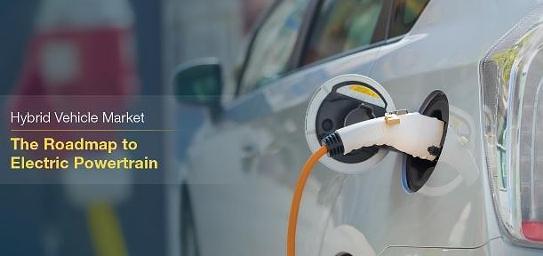Hybrid Vehicle Market by Degree of Hybridization (Full, Micro, and Mild), Propulsion (HEV, PHEV, and NGV), Component (Electric Motor, Battery), and Region
NORTHBROOK, ILLINOIS, UNITED STATES, May 31, 2022 /EINPresswire.com/ — A hybrid vehicle uses more than one type of power source. The most common types of hybrid cars use a combination of an internal combustion engine (ICE) and an electric motor. Hybrid vehicles are designed for better fuel efficiency, more power, and minimum emissions. These vehicles capture electrical energy produced from different sources, such as regenerative braking systems and engines. They can conserve energy by shutting down the engine when the car is parked, idle, or when the electric motor’s energy is sufficient to drive the vehicle without assistance from the ICE.

The Hybrid Vehicle Market is projected to grow at a CAGR of 8.94% during the forecast period, to reach 7,593 thousand units by 2025.
The key growth drivers for the market are demand for zero-emission vehicles, stringent emission norms, government subsidies, better fuel efficiency, and a more extended driving range.
Opportunity: Growth in developing markets
Hybrid vehicles offer immense opportunities for growth in the markets of developing countries because of initiatives and support from governments (e.g., incentives in sales and manufacturing, tax rebates, and increased focus on deploying hybrid commercial vehicles). The Indian government is providing incentives of approximately USD 446 for the purchase of hybrid and electric vehicles in India. The Brazilian government is encouraging the purchase of hybrid vehicles such as plug-in hybrids, hybrid electric, and CNG hybrid by reducing the tax rate. The Mumbai Metropolitan Region Development Authority (MMRDA), India, has awarded a contract to Tata Motors for supplying 25 Tata Starbus Diesel Series Hybrid Electric Buses.
Key Market Players:
Delphi (UK), Continental (Germany), BorgWarner (US), ZF (Germany), Schaeffler (Germany), Toyota (Japan), Ford (US), Volvo (Sweden), Continental (Germany), Honda (Japan), Hyundai (South Korea), Daimler (Germany), Allison Transmission (US), and Nissan (Japan).
Download PDF Brochure @ https://www.marketsandmarkets.com/pdfdownloadNew.asp?id=159441728
The parallel hybrid segment is estimated to be the fastest-growing and the largest market in the hybrid vehicle market during the forecast period
Parallel hybrid is one of the fastest-growing markets by electric powertrain in the hybrid vehicle market due to its less complex system and high performance. It is also suitable for long-distance travel. Also, the energy conversion losses are minimized in a parallel hybrid as the engine and battery are connected to the motor directly. The regenerative braking system is the most commonly used technology in hybrid vehicles. The use of the regenerative braking system and the lesser cost of micro and mild hybrids compared to PHEVs will boost the demand for parallel hybrids. Hence, the parallel hybrid segment is expected to dominate the hybrid vehicle market during the forecast period.
The passenger car segment is the largest segment of the hybrid vehicle market, by vehicle type
The passenger car segment is projected to lead the hybrid vehicle market. The growth can be attributed to the high demand for personal mobility, increasing per capita income, and improved lifestyle, which are the driving factors of the sales of passenger cars. The high sales of passenger cars, stringent emission laws, and increasing demand for mid and large-sized cars are propelling the growth of passenger cars in the hybrid vehicle market. Also, the governments in many countries are providing purchase grants and tax rebates on the purchase or lease of hybrid vehicles.
The Asia Pacific is projected to be the fastest-growing regional market for a hybrid vehicle
The Asia Pacific represents the biggest market for green technologies in the world. The growth of hybrid vehicles in the region is mainly attributed to the huge sales volume in Japan and China. To combat rising emissions, countries in the region are focusing on deploying a large fleet of low-emission vehicles in the next few years. Also, the Asia Pacific region is home to major players in the hybrid vehicle market such as Toyota, Honda, Nissan, Kia, BYD, Hyundai, and others. Toyota has the highest share in hybrid vehicle sales worldwide. Moreover, governments of Asian countries are supporting the growth by providing subsidies which are fueling the hybrid vehicle market in the region.
Request FREE Sample Report @ https://www.marketsandmarkets.com/requestsampleNew.asp?id=159441728
Technology Overview:
1. Micro-Hybrid
2. Mild Hybrid
3. 48V Li-Ion Battery of Mild Hybrid Technology Roadmap
4. Full Hybrid
5. Plug-in Hybrid
6. Higher benefits of mild hybrid vehicles such as low cost, high fuel efficiency and less emission to drive the segment growth
7. Governments in China and Japan are offering incentives and tax rebates on the purchase of mild hybrids
8. Similarly, full hybrids offer robust fuel efficiency and reduced emission due to continual technology upgrade
Source: MarketsandMarkets™ INC

Rod Washington: Rod is a blogger, writer, filmmaker, photographer, daydreamer who likes to cook. Rod produces and directs the web series, CUPIC: Diary of an Investigator. He also produces news and documentary video projects. Check out his podcast StoriesThisMoment at https://m3e.d71.myftpupload.com/stm-tncn-podcasts/


